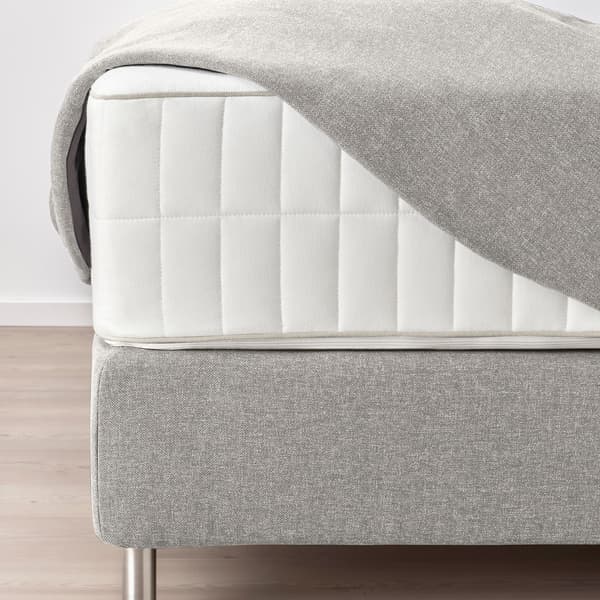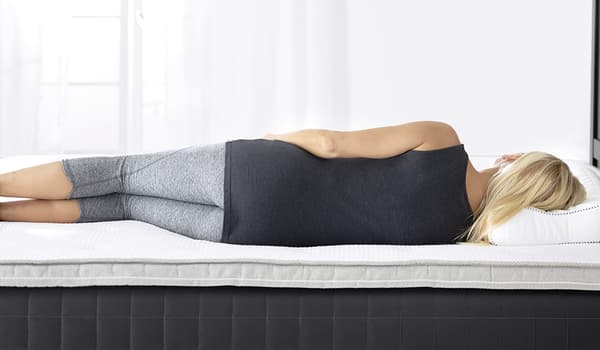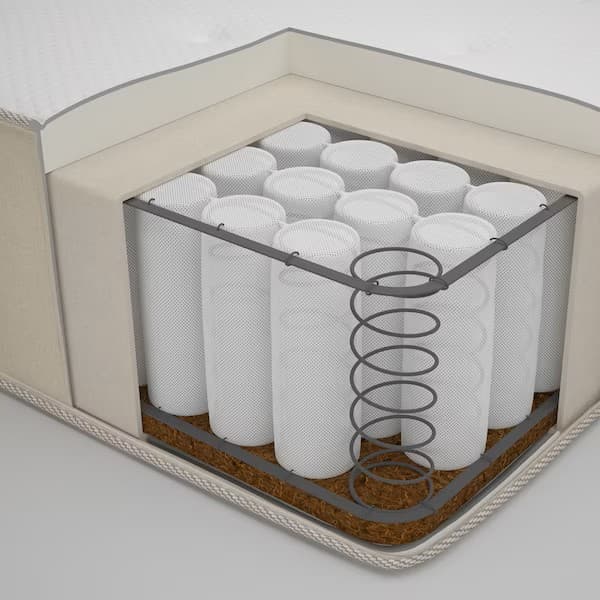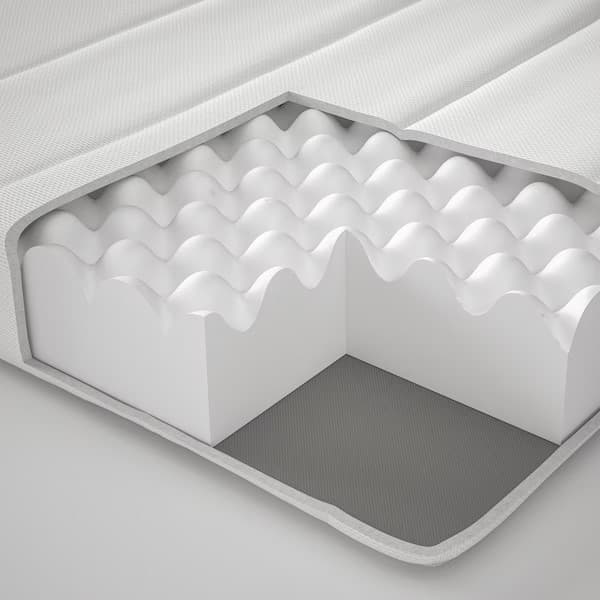Mattress guide
We spend a lot of time sleeping. That's why it's important to choose the right mattress. Find out what firmness levels are, why the perfect mattress is so important for your sleep (and your back), how to keep your mattress clean and why a mattress protector is a good idea. Join us as we explore the world of comfort zones and restful nights.
The different types of mattresses - a comparison
Perhaps the most complex and important topic first: What types of mattress are there and what are their advantages and disadvantages? Let's start with the spring mattress and the pocket spring mattress
The pocket spring mattress is the further development of the (Bonnell) spring core mattress. Here, the springs are no longer distributed "freely" in the mattress, but organised in individual pockets. This makes them even more flexible, stable and comfortable. What both types of mattress have in common is that weight and pressure are evenly distributed. In addition, the air in the mattresses can circulate perfectly, which is good for the sleeping climate. Optimal air circulation can be a relief, especially if you sweat a lot at night. Generally speaking, pocket spring mattresses are best for heavier sleepers. However, both types of mattress are suitable for stomach and back sleepers, and for people who prefer a harder sleeping surface, due to their high level of stability.
Let's move on to the foam mattresses. Firstly: cold foam mattresses. These have come a long way in recent years and are considered the most popular type of mattress alongside spring mattresses. They're flexible and comfortable for people who move around a lot in their sleep and don't want to wake the person next to them. The cold foam also moulds to your body, ensuring that you lie comfortably and stably - in all sleeping positions! Cold foam mattresses are not suitable for people who perspire heavily at night. On the other hand, if you get cold quickly at night, you will love the thermal insulation of your cold foam mattress. Cold foam mattresses also have high point elasticity. This means that 'heavy' parts of the body, such as the shoulders or hips, can sink into the mattress easily, while 'lighter' parts of the body are perfectly supported - a blessing for people who already complain of back pain. A final advantage of the cold foam mattress is its weight. Because it is so light, it is not only easy to transport, but it is also easier to turn over - which is good for hygiene. The memory foam mattress is a special type of foam mattress. The visco-elastic foam used here remembers your sleeping position for a while, even after you have moved or stood up. This is ideal for sleepers who move little or not at all during the night - the mattress's properties then relieve pressure and you lie in an ergonomically perfect position. However, this type of mattress is less suitable for people who move around a lot when they sleep. The 'sleeping cavities' can become uncomfortable.
The next stop in the search for the perfect mattress: the latex mattress. It can be made from natural latex (i.e. natural rubber) or synthetic latex, or a mixture of the two. In general, latex mattresses are ideal for allergy sufferers as they are extremely hygienic and resistant to bacteria. Mites and other pests also find it difficult to settle in latex mattresses. Other advantages? Latex mattresses mould to your body perfectly. They also insulate well, so if you often feel cold at night, a latex mattress could be for you. Even if you are the type of person who rarely lies still at night, a latex mattress is worth considering as it quickly adapts to any new position and is suitable for all sleeping positions. Latex mattresses are usually quite heavy, which makes them difficult to move and turn. They also tend to be quite expensive and require more maintenance than, for example, the much more economical cold foam mattresses.
Finally, we come to our specialists. We are talking about box spring mattresses and allergy mattresses.
Box spring mattresses - as the name suggests - simulate the comfortable box spring bed that you will find in almost every top hotel in the world. A brief explanation of how box spring beds work: box spring beds are based on a two-part lying surface (actually three parts if you add the characteristic topper). The beds do not have a traditional slatted base or frame. Instead, the base (or box) already has a spring core. The mattress is placed on top of the base. The base absorbs the pressure exerted on the mattress when you sleep on it. The mattress, on the other hand, ensures that you lie in the best possible position by giving way where it makes sense (e.g. at the shoulders or hips). Essentially, you are putting two mattresses on top of each other. The result: you sleep as if you were floating. So how does the box spring simulate this increasingly popular principle? It's simple: box spring mattresses have a double spring core that is layered on top of each other. If you then place your box spring mattress on top of a classic slatted frame, you will have almost all the sleeping comfort of a box spring bed, without the sometimes quite high cost of such a bed. You sleep like on clouds and your bed is also very high thanks to the box spring mattress. Ideal for getting up and going to bed easily, which is good for your back in the long run!
A few final words on special mattresses for allergy sufferers: There is no such thing as a general rule on this tricky subject, as it depends very much on the type and severity of the allergy. However, it can be said that latex mattresses are more suitable for allergy sufferers, as it is difficult for mites to settle and the mattresses are particularly hygienic. Cold foam mattresses also offer allergy sufferers a high level of comfort and are mite-resistant. Ultimately, however, you should seek detailed advice. We are happy to work with you to find a solution.
The firmness of the mattress
Now that you know what types of mattress there are, let's move on to the second important topic that will have a huge impact on the quality of your sleep: mattress firmness. Mattresses come in different degrees of hardness or firmness. The main factor is always the weight of the sleeper and other factors such as sleeping habits, preferences or complaints. For example, soft mattresses are more suitable for lighter people, while heavier people are better off with harder mattresses. The reason? Sinking in or support. If you are too light or too heavy, the mattress cannot provide the ideal sleeping surface to keep your spine straight, for example. The result: you wake up tired, sleep poorly or even get back pain. So when it comes to finding the perfect mattress for you, it's all about firmness. And we're going to look at this in more detail:
Which mattress should I choose if I have back pain?
If you already have back problems or back pain, choosing the right mattress is even more important. In this case, we recommend that you visit an IKEA store for a mattress consultation. Together we can find out what you need. And, of course, you can arrange for a test bed right away! Our goal is to help you sleep better and enjoy healthy sleep. This will not only prevent further problems, but can also solve existing ones. Because back pain and back problems are usually very complex, it doesn't hurt to talk to a specialist (such as a neurologist or orthopaedic surgeon).
One thing is for sure: a mattress with comfort zones will probably help you the most. Comfort zones are, as the name suggests, special areas of a mattress that support the body comfortably and precisely, and can therefore further reduce pressure on the shoulders and hips, for example.
What types of mattresses are there?
Here is an overview of the main ones. In each category you will find different options to help you choose the best comfort and support for a good night's sleep.
In spring mattresses, the springs help to keep your body in a comfortable, well-supported position. The weight is evenly distributed throughout the mattress so that no part of the body is overly stressed. They contain at least one layer of foam for added comfort.
Foam and latex mattresses can contain different types of foam, including memory foam. All provide excellent support, mould to the contours of your body and absorb body movements.
Mattress hygiene, cleaning & care
Once you have chosen your new favourite mattress, the second step is hygiene, cleaning and care. The microclimate of your mattress also plays a key role. This determines how well your mattress handles the moisture your body releases during sleep. The type and composition of the mattress are crucial, as are the measures you take to combat moisture. The simplest way is to air the mattress from time to time. There are, of course, many other good mattress care tips.
How can mattresses be cleaned?
Stains, sweat, dust mites - these are all things that can affect your mattress. That's why cleaning and caring for your mattress is so important. Good hygiene means a good night's sleep. If you notice stains early enough, you can remove them with household remedies or a commercial upholstery cleaner. Make sure you use as little water as possible to avoid getting too much liquid into the mattress. If the mattress cover is removable, you can clean it thoroughly in the washing machine. However, make sure that the cover is not too large or heavy for your washing machine! An important tip: Do not clean the mattress with a vacuum cleaner. The suction power is usually not good for the material and the vacuum brush is usually covered in hair, dust and dirt. It is better to use a soft brush to thoroughly remove mites, dust and the like from the mattress. By the way: Sunlight and buttermilk will help with stubborn mould stains. You read that right: Rub a little buttermilk into the stain, let it soak in and then wipe it off with cold water (use water sparingly). However, once a stain has turned into a mildew stain, little else will help. It may be time for a new mattress...
A basic tip: air the mattress well from time to time, for example by placing it vertically in front of an open window.
When and how often should you replace your mattress?
When you need to replace your mattress depends mainly on how well you look after it, how it handles moisture and its quality. For example, if your mattress has a permanent cavity, it should be replaced. The 'cavity' makes sleep bumpy and uncomfortable. Inexpensive mattresses should be replaced every five to eight years, and mattresses without a removable cover (which you can wash in the washing machine) every five years or so. High-quality mattresses last at least 10 years, but can be as long as 15 years. The most important rule is this: As soon as you start to feel uncomfortable, as soon as you feel that your mattress is affecting your sleep, it's time for a change. But before that happens, there's a simple trick you can try (which won't work with every type of mattress): Turn the mattress over! Cold foam or latex mattresses in particular allow you to do this. This is a quick and easy way to get a "new" mattress. Don't wait until it's almost too late. If you turn your mattress once or twice every three months, you will prevent the formation of hollows, help your mattress to reduce moisture and ensure that it wears more evenly and therefore more slowly. Important: For mattresses with comfort zones, always turn the mattress so that the head and foot ends remain in the same position. There is also a very simple method you can use to extend the life of your mattress: Use a mattress topper.
Why are mattress toppers important?
Mattress toppers are like a cheap protective cover for your mattress. A mattress protector is easy to remove and wash while protecting your mattress from stains, moisture and other things. The right mattress protector will extend the life of your mattress, provide extra comfort and improve hygiene.







